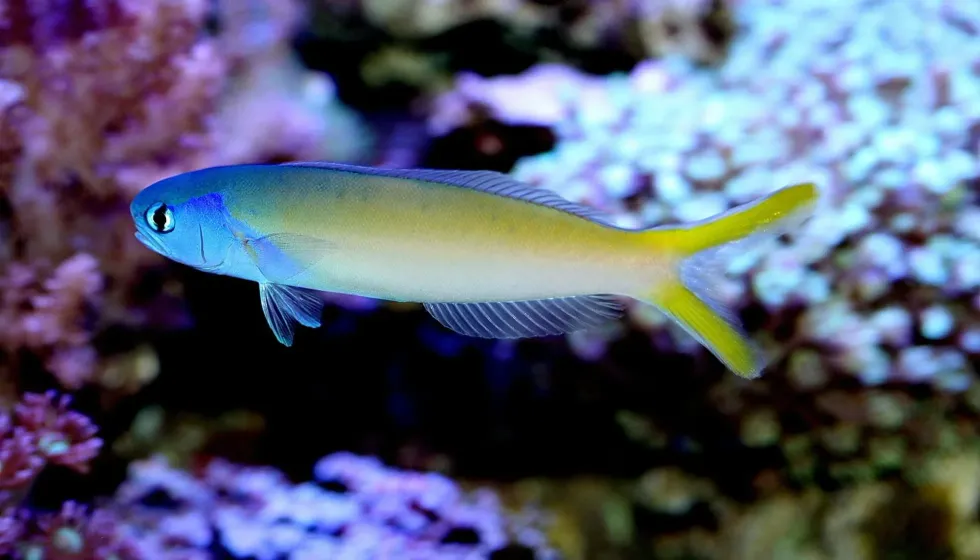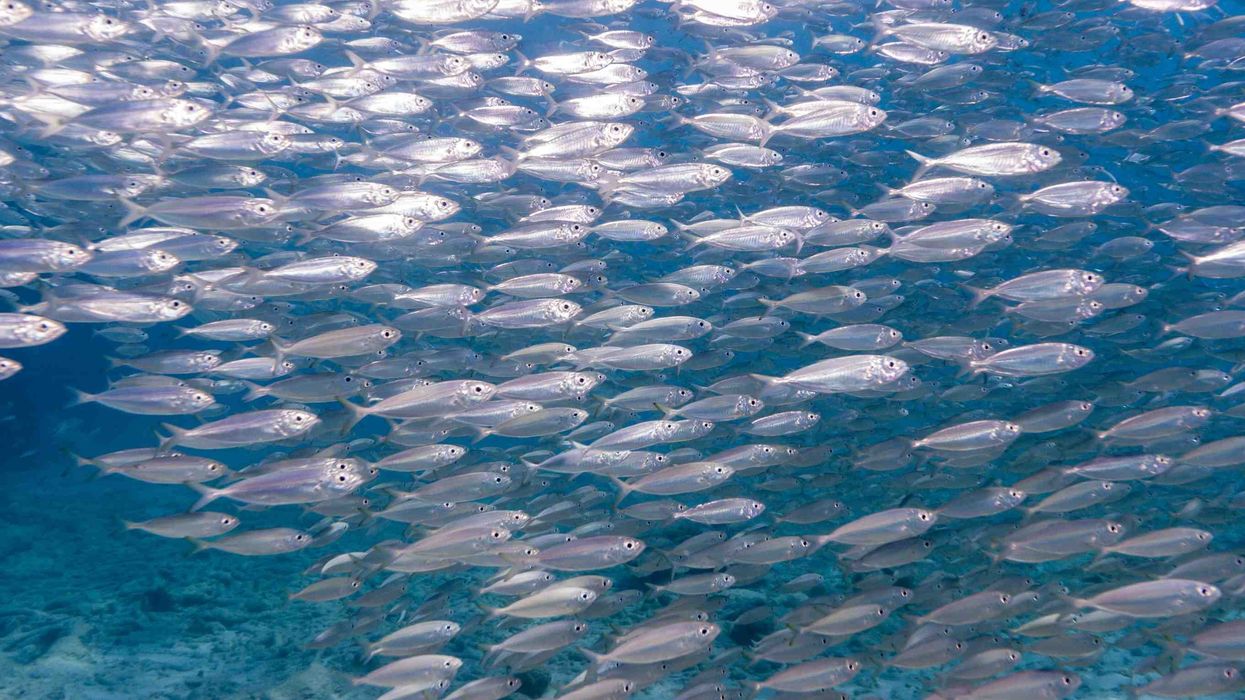A member of the Malacanthidae family, the blueline tilefish (Caulolatilus microps) is found in three different regions: the Gulf of Mexico, the mid-Atlantic, and the south Atlantic. The species is also known as gray tilefish, while in Mexico it is called blanquillo lucio. In North America, this fish is eaten and it is similar in taste to golden tilefish.
The blueline tilefish generally possesses a dull olive-gray color, while the lower parts are white. The species is best known for a thin gold band underlined in blue that is visible from the nose to the end of its eye.
Its robust rectangular body also has extended dorsal and anal fins. The average length of the fish is around 24-35 in (61-89 cm).
The species generally lives at the bottom of water bodies in self-made burrows, caves, piles of rocks, or along the edges of steep slopes. This fish burrows its head in cone-shaped sand piles and a water temperature of around 59-73 F (15-23 C) is considered suitable for this fish.
Blueline tilefish generally spawn from May to October and females can lay over 4 million floating eggs.
The species is found year-round in the Gulf of Mexico, and can also be found year-round or seasonally in the south Atlantic and the mid-Atlantic region. Along with the Gulf of Mexico, you can also find the species in Maine in the north and Texas in the west.
Blueline tilefish feed on crabs, shrimp, snails, worms, sea urchins, and small fish.
The International Union for Conservation of Nature has not evaluated the status of the species as of now, but several fishery management councils have taken measures to regulate blueline tilefish fisheries, and the responsibility for implementing these rules is with NOAA Fisheries.
These measures include permits related to commercial and for-rental vessels, the introduction of catch restrictions for commercial and recreational fisheries, restrictions on fishing depending on the season, and designated areas for the protection of reef fish, sea turtles, and the bottom habitat of these blueline tilefish.
Keep on reading to learn more interesting facts about the blueline tilefish. If you want to know more exciting information about different animals, check out these herring facts and bluegill facts.
Blueline Tilefish Interesting Facts
What type of animal is a blueline tilefish?
The blueline tilefish (Caulolatilus microps) species of the tilefish family is found in three different regions: the Gulf of Mexico, the mid-Atlantic, and the south Atlantic. This fish is caught for commercial purposes by fisheries and it is eaten commonly in North America. It is similar in taste to golden tilefish.
What class of animal does a blueline tilefish belong to?
The blueline tilefish (Caulolatilus microps) belongs to the class of Actinopterygii, the family of Malacanthidae, and the Caulolatilus genus. This fish is protected by fishery management councils such as the Mid-Atlantic Tilefish Fishery Management Plan, the South Atlantic Snapper-Grouper Fishery Management Plan, the Reef Fish Resources of the Gulf of Mexico Fishery Management Plan, and many more.
How many blueline tilefish are there in the world?
The exact population of blueline tilefish is not known as of now, but along with golden tilefish and snapper-grouper species, blueline tilefish come under the top five fish that are harvested commercially. The 10-year commercial landing of snapper-grouper species combined crosses 2 million pounds!
Also, different fishery stocks release population data periodically. No recent population assessment has been performed by the Gulf of Mexico and mid-Atlantic stocks, but a stock assessment revealed that the South Atlantic stock is not currently overfished.
Where does a blueline tilefish live?
Generally, the blueline tilefish (Caulolatilus microps) is found in three different regions: the Gulf of Mexico, the mid-Atlantic, and the south Atlantic, however, you can also find the species in Maine in the north and Texas in the west. The golden tilefish is mostly found in the south Atlantic and the mid-Atlantic region.
What is a blueline tilefish's habitat?
A typical blueline tilefish habitat includes self-made burrows, caves, piles of rocks, and the edges of steep slopes. This fish burrows its head in cone-shaped sand piles in its habitat.
A water temperature of around 59-73 F (15-23 C) is considered suitable for this fish. As these fish are generally used for commercial purposes, they can be found in fisheries, and vessels, as well.
Who does a blueline tilefish live with?
Unlike most fish species in Mexico and the United States, blueline tilefish generally live in groups or schools that include other species such as golden tilefish, northern tilefish, red porgy fish, silk snapper-grouper species, and many more. During the breeding season, these fish are found in pairs.
How long does a blueline tilefish live?
Blueline tilefish generally live for around 26 years. In comparison, a study of NOAA Fisheries revealed that golden tilefish can live up to 40 years. The average life expectancy of males is 39, while females live up to 46 years.
How do they reproduce?
Very little is known about their mating patterns, but it is known that female blueline tilefish generally attain sexual maturity when they turn three. These fish can spawn year-round, but spawning peaks in the month of May. Blueline tilefish generally spawn during the night and female blueline tilefish can lay over 4 million floating eggs when they spawn.
While talking about tilefish in general, these fish are able to mate when their body length reaches 13 in (33 cm) and 3 lb (1.4 kg); approximately when are two to four years old. In the Atlantic region, these fish spawn from March through November and they spawn from January through June in the Gulf of Mexico.
Females can lay 2million to 8 million eggs while spawning.
What is their conservation status?
The International Union for Conservation of Nature has not evaluated the status of the species as of now, but several fishery management councils have taken measures to regulate blueline tilefish fisheries, and the responsibility for implementing these rules is with NOAA Fisheries.
These measures include permits related to commercial and for-rental vessels, the introduction of catch restrictions for commercial and recreational fisheries, restrictions on fishing depending on the season, and designated areas for the protection of reef fish, sea turtles, and the bottom habitat of these blueline tilefish.
Blueline Tilefish Fun Facts
What do blueline tilefish look like?
Blueline tilefish generally possess a dull olive-gray color, while the lower parts are white. The species is best known for a thin gold band underlined in blue that is visible from the nose to the end of its eye. Its robust rectangular body also has extended dorsal and anal fins.
*Please note that this is an image of a bluehead tilefish, not a blueline tilefish. If you have an image of a blueline tilefish, please let us know at hello@kidadl.com.
How cute are they?
The blueline tilefish are large fish found in Mexico and the United States, and they are opportunistic predators. Unlike other big fish, they can live well with other species such as silk snapper fish, vermilion snapper fish, red porgy fish, and many more.
In New Jersey, a northeastern state of the United States, a fish weighing 24 lb (11kg) was once caught, making a new world record!
How do they communicate?
Like other fish, blueline tilefish use similar methods to communicate with each other. Fish generally communicate through skin darkening, their sense of smell, touch, and other methods.
These fish are known for their exceptional eyesight which helps them to catch their prey. Species such as Cameleon sand tilefish are able to change the color of their body to deceive others.
How big is a blueline tilefish?
The average length of a blueline tilefish is around 24-35 in (61-89 cm), while other tilefish species can reach a maximum length of 43 in (109 cm). Blueline tilefish are twice the size of longhorn cowfish and fluke fish.
How fast can a blueline tilefish swim?
Tilefish are known for moving quite fast in deep waters and some species are also able to deceive predators and other fish by changing the color of their bodies. The exact speed of a blueline tilefish is not known as of now, but other big fish can easily reach a speed of 43.5-62 mph (70-100 kph).
How much does a blueline tilefish weigh?
The exact weight of blueline tilefish is not known as of now, but these fish reach sexual maturity when they weigh around 3 lb (1.36 kg). In New Jersey, a northeastern state of the United States, a fish weighing 24 lb (11kg) was once caught, making a new world record!
What are their male and female names of the species?
There are no specific names given to male and female fish and all fish of this species are referred to as blueline tilefish. Male blueline tilefish are bigger than female tilefish. Also, females lay more than 4 million floating eggs while spawning.
What would you call a baby blueline tilefish?
No particular names are used to refer to baby blueline tilefish, but people generally use terms such as young fish or juveniles to refer to the babies of blueline tilefish.
What do they eat?
Blueline tilefish are carnivores and they generally prey on crabs, shrimp, snails, worms, sea urchins, small fish, sea cucumbers, clams, and sea anemones. These bottom-dwelling fish usually feed on invertebrates during the daytime near the seafloor. Also, fish such as spiny dogfish, monkfish, and large bottom-dwelling sharks (such as dusky and sandbar sharks) often prey on young blueline tilefish.
Are they poisonous?
No, blueline tilefish are not poisonous, but they can be really harmful to humans. They are quite big in size and can bite, as well, if they feel threatened or provoked once caught.
Would they make a good pet?
People generally do not consider blueline tilefish as pets. Unlike other pet fish, they are very big and would require a large tank if caught. Also, they are bottom-dwellers and generally move around a lot for their food. Tanks and aquariums cannot serve as their habitats.
Did you know...
The sea bass family resembles the tilefish.
Do humans eat them?
Yes, people eat blueline tilefish, especially during the blueline tilefish season. The fish has a mild taste that is similar to that of lobster or crab. They are also similar in taste to golden tilefish. The species is also a great source of protein, vitamin B12, niacin, and selenium.
Why is it called tilefish?
This fish's unusual appearance gives it the name tilefish. It possesses a thin gold band underlined in blue that is visible from the nose to the end of its eye, giving it its name. Tilefish are also known as the clown of the sea.
Here at Kidadl, we have carefully created lots of interesting family-friendly animal facts for everyone to discover! Learn more about some other fish from our cuttlefish facts and swai fish facts pages.
You can even occupy yourself at home by coloring in one of our free printable Tilefish coloring pages.










